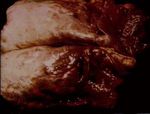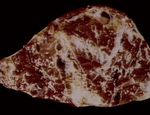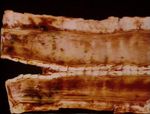Difference between revisions of "Acute Bovine Pulmonary Emphysema and Oedema"
Jump to navigation
Jump to search
| Line 30: | Line 30: | ||
[[Category:Respiratory Diseases - Cattle]] | [[Category:Respiratory Diseases - Cattle]] | ||
[[Category:Pneumonia]] | [[Category:Pneumonia]] | ||
| + | [[Category:To Do - Respiratory]][[Category:To Do - Major]] | ||
Latest revision as of 14:58, 9 May 2011
Acute bovine pulmonary emphysema and oedema (ABPEE)
- Synonym: fog fever
- Usually seen in adult beef cattle in the autumn as an outbreak
- Associated with a change in pasture (from dry to lush, green)
- Severe respiratory distress with laboured breathing and grunting on expiration
- Causes Interstitial Pneumonia
- Can result in diffuse fibrosing alveolitis
- Gross appearance is that of enlarged wet lungs, the interlobular septa are markedly widenedith oedema and emphysema
- Underlying pathogenesis is ingestion of L-tryptophan in the pasture which is metabolised to 3-methylindole -> bloodstream -> lungs -> metabolised into a compound toxic to Type 1 pneumonocytes and non-ciliated bronchiolar epithelium
- Their loss allows massive flooding of the alveoli with a protein-rich fluid
- The sequence of events in the lung is as follows:
- Alveolar flooding with a protein-rich fluid due to the necrosis of Type 1 epithelium
- As the incoming air dries this fluid, fibrinous 'hyaline membranes' form
- Proliferation of the more resistant cuboidal Type 2 epithelium which line the alveoli, called 'epithelialisation'
- Then either there is
- Digestion of the hyaline membranes by macrophages which when completed, allows some of the proliferated Type 2 epithelium to differentiate into Type 1 and reconstitute the functional respiratory unit - a normal alveolus
- Or
- Organisation of the fibrin into fibrous tissue in the lumen - destroying the alveolus or proliferation of fibrous tissue in the alveolar wall with retention of the epithelialised appearance to the alveolus
- Sequel
- Residual scarring if animal survives initial onslaught
- In chronic exposures there may be extensive fibroplasia
- Ingestion of sweet potatoes ifested with Fusarium solani mould or pasture contaminated with stinkweed or purple mint, rapeseed and kale also cause pulmonary oedema, emphysema and interstitial pneumonia


